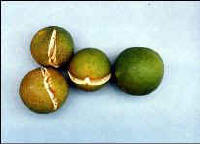Citrus trees require a lot of care and attention to produce good quality fruit, yet even the most careful gardeners may run into the problem of split-fruit on their citrus trees. Split-fruit is a condition which strikes citrus trees in September and October and can wipe out a hundred or more fruit on a single tree. Researchers at the University of Florida have been studying fruit splitting for many years. Clear cut causes or solutions have not been found. My information on fruit splitting was provided by Extension Fruit Crop Specialist, Dr. Pete Andersen with IFAS located at Quincy, North Florida Research and Education Center.
Researchers have found that certain varieties of citrus tend to split more often than other. “Sweet Oranges” Tangelos” and certain varieties of Satsuma’s tend to split more than citrus which is not sweet. Grapefruit and acid fruits, such as lemons and limes rarely split.
The condition is known to be more common in seedlings and young trees than in older, more settled trees. However, split-fruit can be a very serious problem when it occurs on mature trees, because they usually have more fruit to lose.
Another condition which will cause fruit to split is insufficient copper in the soil. This used to be a much greater problem than it is today, due to the wide-spread use of copper in most fertilizer and spray programs. Potassium deficiency results in small, firm fruit with thin peels and increased fruit splitting. However, added potassium doesn’t correct splitting related to citrus varieties.
The most commonly held belief is that fruit splitting is caused by climatic conditions, since it only seems to occur at one time of the year. During the late summer and high humidity, followed by periods of drought. After a series of heavy rains, the trees absorb a great deal of moisture and force it into the fruit. Since the fruit is near maturity, the rind becomes less pliable and can’t expand rapidly enough to absorb the great volume of water from the trees. As a result the fruit splits.
Despite these findings, there are numerous cases of fruit splitting that doesn’t appear to be related to any of the above conditions. When the cause of the split is not fully understood, there is not absolute method of control. Also, there is no way to stop fruit splitting while it is occurring. The problem must be prevented before it starts. Attempts to control splitting through irrigation practices, fertilization and growth regulators have met with some success.
Fertilizer and irrigation practices won’t cure splitting, but may help to avoid large increase in the number of split fruit. In addition, growth regulators are available which can thicken the peel of the orange. Thicker peels have been found to split much less often that the thinner peels, due to their ability to withstand extra water pressure during the critical moths of the year.
If fruit splitting is a problem this year follow a recommended fertilizer program next year. This will insure a good supply of minor nutrients, especially copper. Make sure to keep the trees well watered during the dry periods of late summer and early fall. This will keep the fruit from swelling too rapidly, and splitting as a result.
- Muscadine Grape: a Popular Fruit for North Florida - August 10, 2015
- Southern Field Peas, a Summer Delight - July 14, 2015
- Caterpillars with a Sting - June 10, 2015

